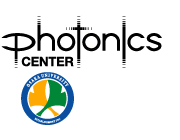【研究成果】2011
研究成果25
Covalent Protein Labeling with a Lanthanide Complex and Its Application to Photoluminescence Lifetime-Based Multicolor Bioimaging
Shin Mizukami, Taku Yamamoto, Akimasa Yoshimura, Shuji atanabe, Kazuya Kikuchi
Angewandte Chemie International Edition Volume 50, Issue 37, pages 8750–8752, September 5, 2011


Short (organicfluorophores MitoTracker Orange) and long (lanthanides TPA-Eu) lifetime PL components were drawn with different pseudocolors (pseudo color: green for prompt PL and red for delayed PL). Scale bar: 50 μ m.
We designed and synthesized a novel luminescent europium(III) complex probe, TPA-Eu. Combined with TRL microscopy, we could separate live-cell imaging from background autofluorescence. The long-lifetime PL of TPA-Eu labels on cell surface proteins can be selectively detected even in the presence of FBS. The covalent probe labeling enabled long time-lapse imaging lasting at least several hours. Both of these virtues are quite valuable especially for in vivo imaging experiments, because the autofluorescence of animal bodies severely hampers detection of faint PL signals, and in vivo studies usually take at least several hours. For further applications, intracellular protein labeling may be desired. As we expected from the anionic structure, TPA-Eu did not permeate into living cells. More hydrophobic or cationic lanthanide complexes should be chosen for intracellular protein labeling.
We also demonstrated a unique application—lifetime based multicolor imaging—by exploiting pulse-gating technology. This multicolor imaging system would yield almost the same data as multicolor fluorescence imaging with different filter sets. Because this technique is orthogonal to the conventional wavelength-based multicolor imaging, simultaneous use of both wavelength-based and lifetimebased multicolor imaging techniques could increase the number of color channels. For example, three emission filter sets (blue, green, and red) and two lifetime settings (short and long) yield six channels. Considering that differently colored luminescent lanthanides such as terbium(III) or dysprosium(III) are also suitable for TRL measurements, simultaneous imaging of a larger number of proteins can be achieved in future.



